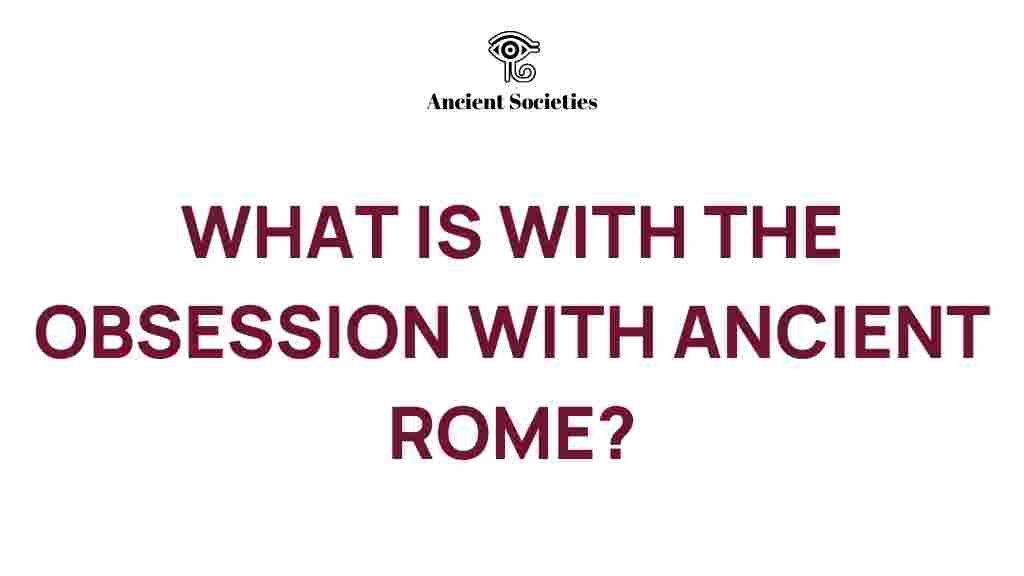Unraveling the Enduring Fascination with Ancient Rome
Ancient Rome has long captivated the imagination of historians, scholars, and enthusiasts alike. This remarkable civilization, known for its extensive influence on architecture, culture, and governance, has left an indelible mark on the world. With a legacy that transcends time, exploring the history and achievements of Ancient Rome offers profound insights into the complexities of human civilization. In this article, we will delve into the various aspects of Ancient Rome, including its culture, architecture, and lasting influence on modern society.
The Rise of Ancient Rome
The story of Ancient Rome begins in the 8th century BCE, with its foundation according to legend in 753 BCE by Romulus and Remus. Initially a small settlement along the Tiber River, Rome grew to become a powerful empire that dominated much of the Mediterranean world. The key phases in the development of Ancient Rome include:
- The Roman Kingdom (753-509 BCE): Rome was ruled by kings, with a focus on establishing governance and military strength.
- The Roman Republic (509-27 BCE): A complex system of elected officials and checks and balances emerged, leading to greater civic involvement.
- The Roman Empire (27 BCE-476 CE): The empire reached its zenith, expanding its territory across Europe, North Africa, and parts of Asia.
Each of these phases contributed to the rich tapestry of Roman civilization, setting the stage for its enduring legacy.
Culture of Ancient Rome
The culture of Ancient Rome was a vibrant blend of various influences, including Etruscan, Greek, and indigenous Italic traditions. This eclecticism is evident in various aspects of Roman life:
- Religion: Romans practiced polytheism, worshipping a pantheon of gods and goddesses, often incorporating deities from conquered territories.
- Literature: The works of poets like Virgil and Ovid, as well as historians such as Tacitus and Livy, remain foundational texts in Western literature.
- Public Life: The forum was the heart of Roman public life, where citizens gathered for political discussions, social events, and commerce.
Roman culture was characterized by its emphasis on civic duty, public service, and a strong military ethos, which contributed to the stability and expansion of the empire.
Architecture: A Testament to Roman Ingenuity
One of the most enduring legacies of Ancient Rome is its architecture. Roman engineering and architectural techniques set the standard for future civilizations. Key examples include:
- The Colosseum: An iconic symbol of Rome, this amphitheater showcased the grandeur of Roman architecture and was a venue for gladiatorial contests and public spectacles.
- Aqueducts: Remarkable feats of engineering, aqueducts transported water from distant sources into cities, revolutionizing urban living.
- Roman Baths: These public bathing facilities were centers of social life, featuring intricate designs and advanced heating systems.
The architectural innovations of Ancient Rome, such as the use of the arch and concrete, laid the groundwork for modern construction techniques.
The Influence of Ancient Rome
The influence of Ancient Rome can be seen in various aspects of contemporary society:
- Legal Systems: Many modern legal frameworks are based on Roman law, emphasizing the concepts of justice and citizenship.
- Language: Latin, the language of Ancient Rome, is the precursor to the Romance languages and has also influenced modern English vocabulary.
- Government: The republican model developed in Rome has inspired democratic systems worldwide.
In this way, Ancient Rome’s influence continues to permeate our lives, shaping culture, governance, and law.
The Legacy of Ancient Rome
The legacy of Ancient Rome is vast and multifaceted. It is preserved not only in the ruins that dot the landscape of Europe but also in the cultural practices that endure today. Key aspects of this legacy include:
- Archaeological Sites: The remnants of ancient structures provide invaluable insights into Roman life and society.
- Art and Literature: The artistic and literary achievements of Ancient Rome continue to be studied and celebrated.
- Historical Narratives: The histories written by Roman authors inform our understanding of the ancient world.
For more on the archaeological aspects of Ancient Rome, you can explore this detailed study.
Exploration of Ancient Rome Today
Modern exploration of Ancient Rome involves not only archaeological excavations but also digital technologies that allow us to visualize the past. Key methods include:
- Archaeological Excavations: Ongoing digs in Rome and surrounding areas continue to uncover new artifacts and buildings, shedding light on previously unknown aspects of Roman life.
- Virtual Reality: Using VR technology, historians and enthusiasts can experience reconstructions of ancient sites, providing an immersive way to understand Roman architecture.
- Academic Research: Scholars are continually revisiting ancient texts and artifacts to gain fresh perspectives on Roman civilization.
This blend of tradition and technology ensures that the exploration of Ancient Rome remains vibrant and relevant.
Troubleshooting Common Misconceptions about Ancient Rome
As we explore Ancient Rome, it’s essential to address some common misconceptions:
- Myth: The Romans were purely conquerors. While military expansion was significant, the Romans were also skilled diplomats and builders who promoted trade and cultural exchange.
- Myth: All Romans lived lavish lifestyles. In reality, Roman society was highly stratified, and many citizens faced economic hardships.
- Myth: The fall of the Roman Empire was sudden. The decline of the empire was a gradual process influenced by various factors, including economic troubles and external invasions.
By addressing these misconceptions, we can foster a more nuanced understanding of this complex civilization.
Conclusion
The enduring fascination with Ancient Rome stems from its remarkable achievements and profound influence on contemporary society. From its rich culture and architectural marvels to its legal and governmental legacies, Ancient Rome continues to inspire exploration and scholarship. As we delve deeper into its history, we uncover not only the stories of its past but also the foundational elements that shape our present and future.
In exploring Ancient Rome, we not only honor its legacy but also gain insights that are crucial for understanding the evolution of civilization itself.
This article is in the category Culture and created by AncientSocieties Team
